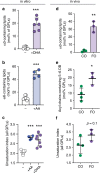Lipidomic and biophysical homeostasis of mammalian membranes counteracts dietary lipid perturbations to maintain cellular fitness
- PMID: 32165635
- PMCID: PMC7067841
- DOI: 10.1038/s41467-020-15203-1
Lipidomic and biophysical homeostasis of mammalian membranes counteracts dietary lipid perturbations to maintain cellular fitness
Abstract
Proper membrane physiology requires maintenance of biophysical properties, which must be buffered from external perturbations. While homeostatic adaptation of membrane fluidity to temperature variation is a ubiquitous feature of ectothermic organisms, such responsive membrane adaptation to external inputs has not been directly observed in mammals. Here, we report that challenging mammalian membranes by dietary lipids leads to robust lipidomic remodeling to preserve membrane physical properties. Specifically, exogenous polyunsaturated fatty acids are rapidly incorporated into membrane lipids, inducing a reduction in membrane packing. These effects are rapidly compensated both in culture and in vivo by lipidome-wide remodeling, most notably upregulation of saturated lipids and cholesterol, resulting in recovery of membrane packing and permeability. Abrogation of this response results in cytotoxicity when membrane homeostasis is challenged by dietary lipids. These results reveal an essential mammalian mechanism for membrane homeostasis wherein lipidome remodeling in response to dietary lipid inputs preserves functional membrane phenotypes.
Conflict of interest statement
The authors declare no competing interests.
Figures






Similar articles
-
Homeostatic control of membrane fatty acid composition in the rat after dietary lipid treatment.Lipids. 1984 Dec;19(12):942-51. doi: 10.1007/BF02534730. Lipids. 1984. PMID: 6527613
-
Effect of dietary lipids on plasma lipoproteins and fluidity of lymphoid cell membranes in normal and leukemic mice.Biochim Biophys Acta. 1988 Aug 18;943(2):166-74. doi: 10.1016/0005-2736(88)90548-2. Biochim Biophys Acta. 1988. PMID: 3401476
-
Variations in dietary triacylglycerol saturation alter the lipid composition and fluidity of rat intestinal plasma membranes.Biochim Biophys Acta. 1985 Jan 25;812(2):460-72. doi: 10.1016/0005-2736(85)90321-9. Biochim Biophys Acta. 1985. PMID: 3967022
-
Homeoviscous Adaptation and the Regulation of Membrane Lipids.J Mol Biol. 2016 Dec 4;428(24 Pt A):4776-4791. doi: 10.1016/j.jmb.2016.08.013. Epub 2016 Aug 14. J Mol Biol. 2016. PMID: 27534816 Review.
-
Dietary fats and membrane function: implications for metabolism and disease.Biol Rev Camb Philos Soc. 2005 Feb;80(1):155-69. doi: 10.1017/s1464793104006578. Biol Rev Camb Philos Soc. 2005. PMID: 15727042 Review.
Cited by
-
Understanding the effects of omega-3 fatty acid supplementation on the physical properties of brain lipid membranes.iScience. 2024 Jun 24;27(7):110362. doi: 10.1016/j.isci.2024.110362. eCollection 2024 Jul 19. iScience. 2024. PMID: 39071883 Free PMC article.
-
Proteolysis modification targeting protein corona affects ultrasound-induced membrane homeostasis of saccharomyces cerevisiae: Analysis of lipid relative contributions on membrane properties.Front Microbiol. 2023 Jan 26;14:1082666. doi: 10.3389/fmicb.2023.1082666. eCollection 2023. Front Microbiol. 2023. PMID: 36778851 Free PMC article.
-
Mutant APC reshapes Wnt signaling plasma membrane nanodomains by altering cholesterol levels via oncogenic β-catenin.Nat Commun. 2023 Jul 19;14(1):4342. doi: 10.1038/s41467-023-39640-w. Nat Commun. 2023. PMID: 37468468 Free PMC article.
-
Low membrane fluidity triggers lipid phase separation and protein segregation in living bacteria.EMBO J. 2022 Mar 1;41(5):e109800. doi: 10.15252/embj.2021109800. Epub 2022 Jan 17. EMBO J. 2022. PMID: 35037270 Free PMC article.
-
A theoretical model of dietary lipid variance as the origin of primary ciliary dysfunction in preeclampsia.Front Mol Biosci. 2023 May 5;10:1173030. doi: 10.3389/fmolb.2023.1173030. eCollection 2023. Front Mol Biosci. 2023. PMID: 37251083 Free PMC article.
References
Publication types
MeSH terms
Substances
Grants and funding
LinkOut - more resources
Full Text Sources
Medical

